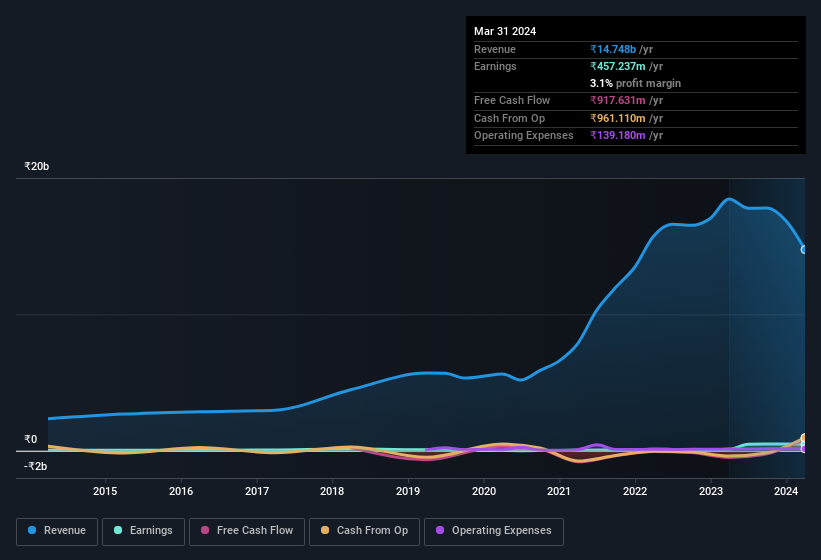- India
- /
- Electrical
- /
- NSEI:BHAGYANGR
We Think Bhagyanagar India's (NSE:BHAGYANGR) Solid Earnings Are Understated

The stock was sluggish on the back of Bhagyanagar India Limited's (NSE:BHAGYANGR) recent earnings report. We have done some analysis, and found some encouraging factors that we believe the shareholders should consider.
See our latest analysis for Bhagyanagar India

Examining Cashflow Against Bhagyanagar India's Earnings
As finance nerds would already know, the accrual ratio from cashflow is a key measure for assessing how well a company's free cash flow (FCF) matches its profit. In plain english, this ratio subtracts FCF from net profit, and divides that number by the company's average operating assets over that period. This ratio tells us how much of a company's profit is not backed by free cashflow.
As a result, a negative accrual ratio is a positive for the company, and a positive accrual ratio is a negative. While it's not a problem to have a positive accrual ratio, indicating a certain level of non-cash profits, a high accrual ratio is arguably a bad thing, because it indicates paper profits are not matched by cash flow. Notably, there is some academic evidence that suggests that a high accrual ratio is a bad sign for near-term profits, generally speaking.
Over the twelve months to March 2024, Bhagyanagar India recorded an accrual ratio of -0.14. That indicates that its free cash flow was a fair bit more than its statutory profit. In fact, it had free cash flow of ₹918m in the last year, which was a lot more than its statutory profit of ₹457.2m. Given that Bhagyanagar India had negative free cash flow in the prior corresponding period, the trailing twelve month resul of ₹918m would seem to be a step in the right direction.
Note: we always recommend investors check balance sheet strength. Click here to be taken to our balance sheet analysis of Bhagyanagar India.
Our Take On Bhagyanagar India's Profit Performance
As we discussed above, Bhagyanagar India has perfectly satisfactory free cash flow relative to profit. Based on this observation, we consider it likely that Bhagyanagar India's statutory profit actually understates its earnings potential! Better yet, its EPS are growing strongly, which is nice to see. At the end of the day, it's essential to consider more than just the factors above, if you want to understand the company properly. So if you'd like to dive deeper into this stock, it's crucial to consider any risks it's facing. For example - Bhagyanagar India has 3 warning signs we think you should be aware of.
Today we've zoomed in on a single data point to better understand the nature of Bhagyanagar India's profit. But there are plenty of other ways to inform your opinion of a company. For example, many people consider a high return on equity as an indication of favorable business economics, while others like to 'follow the money' and search out stocks that insiders are buying. So you may wish to see this free collection of companies boasting high return on equity, or this list of stocks with high insider ownership.
Valuation is complex, but we're here to simplify it.
Discover if Bhagyanagar India might be undervalued or overvalued with our detailed analysis, featuring fair value estimates, potential risks, dividends, insider trades, and its financial condition.
Access Free AnalysisHave feedback on this article? Concerned about the content? Get in touch with us directly. Alternatively, email editorial-team (at) simplywallst.com.
This article by Simply Wall St is general in nature. We provide commentary based on historical data and analyst forecasts only using an unbiased methodology and our articles are not intended to be financial advice. It does not constitute a recommendation to buy or sell any stock, and does not take account of your objectives, or your financial situation. We aim to bring you long-term focused analysis driven by fundamental data. Note that our analysis may not factor in the latest price-sensitive company announcements or qualitative material. Simply Wall St has no position in any stocks mentioned.
About NSEI:BHAGYANGR
Slight and slightly overvalued.
Similar Companies
Market Insights
Community Narratives




